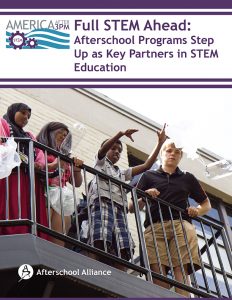Brief
Full STEM Ahead
After-School Programs Step Up as Key Partners in STEM Education
Connected Science Learning March 2016 (Volume 1, Issue 1)
By Anita Krishnamurthi

Full STEM Ahead: Afterschool Programs Step Up as Key Partners in STEM Education, describes parental attitudes and perceptions of STEM programming in their child’s after-school setting.
The America After 3PM survey is the nation’s most comprehensive household survey of how children spend the hours after school and asks parents and guardians of school-age children in the United States about availability and access to after-school programs. The 2014 survey, which followed prior surveys conducted in 2004 and 2009, reveals that over the past decade, the number of children in after-school programs has grown from 6.5 million to more than 10 million. Parents of an additional 19.4 million children would enroll their children in a program if one were available to them.

In addition to asking for information about after-school programs generally, the 2014 America After 3PM survey was the first to ask about children’s participation in programs offering STEM-learning opportunities, making it possible to produce a special report on STEM. Full STEM Ahead: Afterschool Programs Step Up as Key Partners in STEM Education, describes parental attitudes and perceptions of STEM programming in their child’s after-school setting.
Findings
The large number of households surveyed allows us to report responses across regions and demographics including income, race and ethnicity, and gender; analyze differences in the demand for, access to, and satisfaction in after-school programs by income, race, and ethnicity; and determine the opportunity gaps that persist. Key findings of the report:
- Parents consider STEM when choosing their child’s after-school program. While parents report that many factors are important to them in selecting their child’s after-school program, more than half (53%) said that STEM-learning opportunities were very important in their decision. Of parents who shared that STEM-learning opportunities were very important in selecting their child’s after-school program, 85% were satisfied with their after-school program’s STEM-learning opportunity.
- There is a high level of satisfaction with after-school STEM programs. Close to seven in 10 parents (69%) are satisfied with their child’s after-school STEM-learning opportunities. Parents who report their children have after-school STEM-learning opportunities are more satisfied, with eight in 10 reporting satisfaction with STEM programming.
- After-school programs activate student interest in STEM. Approximately two in three parents (65%) agree that after-school programs can help children gain STEM-related interests and skills, and 70% of parents think that after-school programs should provide hands-on STEM-learning opportunities for young people.
- After-school programs allow students to become immersed in STEM and build fluency in these subjects. For children who were offered STEM activities in their after-school programs, parents report that 52% were offered such opportunities more than once a week and three quarters had them at least once a week.
- After-school programs help reduce inequities in STEM participation by reaching populations traditionally under-represented in STEM. Among parents who report that their child is offered STEM-learning opportunities in after-school:
- Parents report that 69% of both boys and girls are offered STEM-learning opportunities in after-school programs and parents of boys and girls both report similar satisfaction with their child’s involvement in his or her after-school STEM program. Eighty percent of boys and 73% of girls participate in after-school STEM programming once a week or more.
- Parents of children from low-income families express strong support for after-school STEM programs, more so than affluent parents. For example, 57% of low-income parents place an emphasis on STEM when selecting their child’s after-school program, compared to 50% of more affluent parents; 73% of low-income parents also agree that after-school programs should provide opportunities to explore and engage in hands-on STEM learning, compared to 68% of more affluent parents.
African American and Hispanic parents have a more positive opinion of and experience with after-school STEM programs compared to Caucasian parents. For example, 60% of African-American and 57% of Hispanic parents consider the availability of STEM programs as an important factor when choosing their child’s after-school program, compared to 47% of Caucasian parents. Seventy percent of African-American parents and 68% of Hispanic parents report higher levels of satisfaction, compared to 63% of Caucasian parents.
Anita Krishnamurthi (AKrishnamurthi@afterschoolalliance.org) is Vice President for STEM Policy at the Afterschool Alliance in Washington, DC.
STEM Middle School Elementary High School Informal Education


